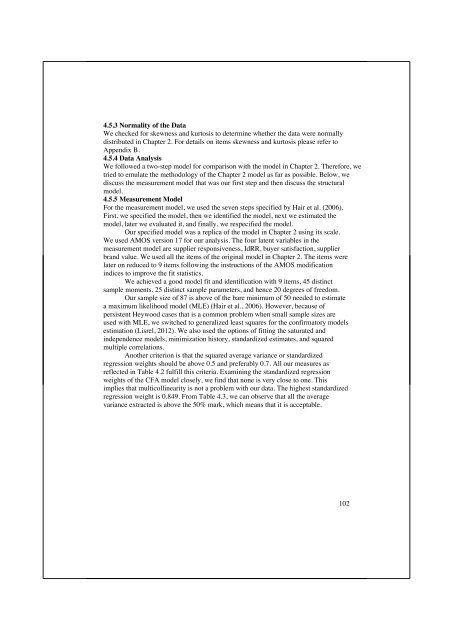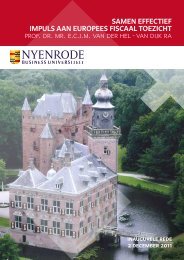Essays on supplier responsiveness and buyer firm value - Nyenrode ...
Essays on supplier responsiveness and buyer firm value - Nyenrode ...
Essays on supplier responsiveness and buyer firm value - Nyenrode ...
You also want an ePaper? Increase the reach of your titles
YUMPU automatically turns print PDFs into web optimized ePapers that Google loves.
4.5.3 Normality of the Data<br />
We checked for skewness <strong>and</strong> kurtosis to determine whether the data were normally<br />
distributed in Chapter 2. For details <strong>on</strong> items skewness <strong>and</strong> kurtosis please refer to<br />
Appendix B.<br />
4.5.4 Data Analysis<br />
We followed a two-step model for comparis<strong>on</strong> with the model in Chapter 2. Therefore, we<br />
tried to emulate the methodology of the Chapter 2 model as far as possible. Below, we<br />
discuss the measurement model that was our first step <strong>and</strong> then discuss the structural<br />
model.<br />
4.5.5 Measurement Model<br />
For the measurement model, we used the seven steps specified by Hair et al. (2006).<br />
First, we specified the model, then we identified the model, next we estimated the<br />
model, later we evaluated it, <strong>and</strong> finally, we respecified the model.<br />
Our specified model was a replica of the model in Chapter 2 using its scale.<br />
We used AMOS versi<strong>on</strong> 17 for our analysis. The four latent variables in the<br />
measurement model are <strong>supplier</strong> resp<strong>on</strong>siveness, IdRR, <strong>buyer</strong> satisfacti<strong>on</strong>, <strong>supplier</strong><br />
br<strong>and</strong> <strong>value</strong>. We used all the items of the original model in Chapter 2. The items were<br />
later <strong>on</strong> reduced to 9 items following the instructi<strong>on</strong>s of the AMOS modificati<strong>on</strong><br />
indices to improve the fit statistics.<br />
We achieved a good model fit <strong>and</strong> identificati<strong>on</strong> with 9 items, 45 distinct<br />
sample moments, 25 distinct sample parameters, <strong>and</strong> hence 20 degrees of freedom.<br />
Our sample size of 87 is above of the bare minimum of 50 needed to estimate<br />
a maximum likelihood model (MLE) (Hair et al., 2006). However, because of<br />
persistent Heywood cases that is a comm<strong>on</strong> problem when small sample sizes are<br />
used with MLE, we switched to generalized least squares for the c<strong>on</strong><strong>firm</strong>atory models<br />
estimati<strong>on</strong> (Lisrel, 2012). We also used the opti<strong>on</strong>s of fitting the saturated <strong>and</strong><br />
independence models, minimizati<strong>on</strong> history, st<strong>and</strong>ardized estimates, <strong>and</strong> squared<br />
multiple correlati<strong>on</strong>s.<br />
Another criteri<strong>on</strong> is that the squared average variance or st<strong>and</strong>ardized<br />
regressi<strong>on</strong> weights should be above 0.5 <strong>and</strong> preferably 0.7. All our measures as<br />
reflected in Table 4.2 fulfill this criteria. Examining the st<strong>and</strong>ardized regressi<strong>on</strong><br />
weights of the CFA model closely, we find that n<strong>on</strong>e is very close to <strong>on</strong>e. This<br />
implies that multicollinearity is not a problem with our data. The highest st<strong>and</strong>ardized<br />
regressi<strong>on</strong> weight is 0.849. From Table 4.3, we can observe that all the average<br />
variance extracted is above the 50% mark, which means that it is acceptable.<br />
102
















